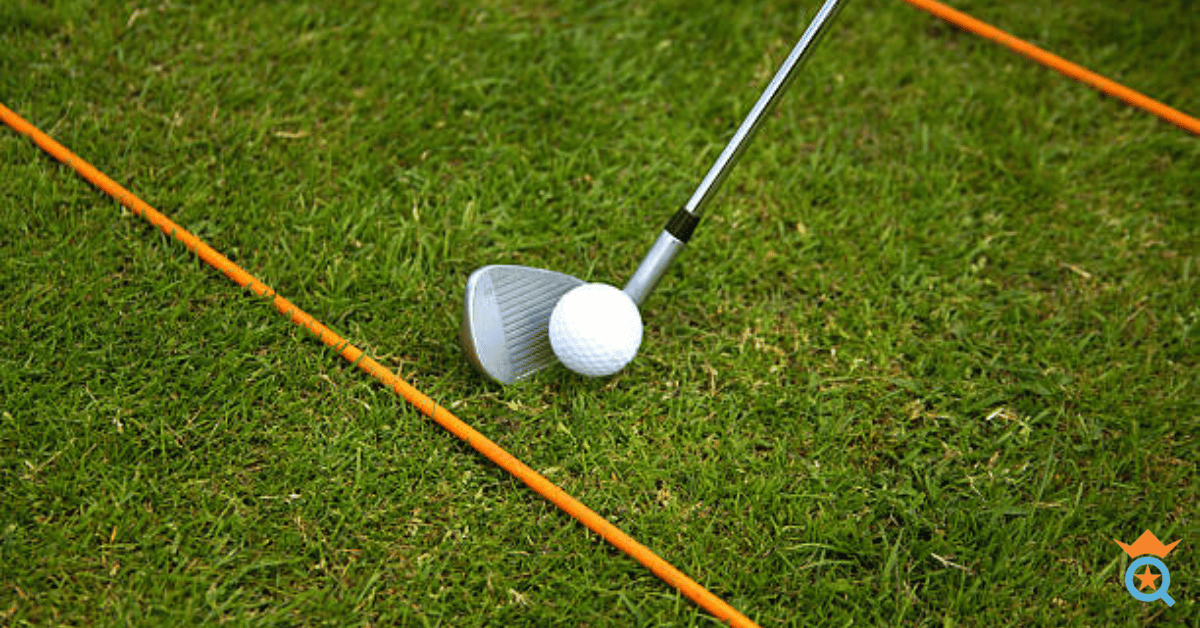In golf, the art of putting may appear straightforward compared to the complexities of swinging a golf club, but mastering it demands accuracy and dedication. Professionals dedicate countless hours to honing their putting skills through various drills. This article will delve into 12 top-notch putting drills that can be practiced at home or on the green to elevate your putting prowess.
1. Tee Box Drill
The Tee Box Drill is a classic and effective putting exercise designed to help golfers ensure their putter moves on the correct path and that the ball starts on the intended line.
By setting up a simple "gate" using tees, golfers can practice maintaining a consistent, straight stroke while receiving immediate feedback if they deviate from the ideal path.
This drill helps build muscle memory for an accurate and reliable putting stroke and instills confidence in a golfer's ability to start the ball on the desired line, increasing the chances of sinking putts during crucial moments on the course.

2. Coin Balance Tempo Drill
The Coin Balance Tempo Drill is a simple yet effective way to enhance the tempo of your putting stroke by promoting a smooth transition throughout the movement.
By balancing a coin on the back of the putter head, golfers must maintain a steady and fluid stroke to prevent the coin from falling off. This drill not only helps in refining the overall tempo but also in avoiding abrupt changes in speed and direction that could impact the consistency and accuracy of the putt.
As a result, the Coin Balance Tempo Drill is an excellent addition to any golfer's practice routine, leading to more confident and reliable putting on the course.

3. Clock Face Drill
The Clock Face Drill is a widely-used putting practice among PGA Tour professionals, designed to help golfers become more adept at sinking putts from varying distances and angles. The drill simulates the hours on a clock, with the golfer positioned at different points around the hole, practicing putts from multiple angles.
This exercise enhances a golfer's ability to read greens and adjust their stroke accordingly but also aids in building confidence and consistency in putting.
By systematically working around the hole, golfers can identify any weaknesses in their putting game, making the Clock Face Drill an essential component of a well-rounded practice routine for golfers of all skill levels.

4. Wedge Putting Drill
The Wedge Putting Drill is an unconventional yet highly effective practice technique, famously endorsed by Tiger Woods, to help golfers develop a better feel for the end-over-end roll of the ball during a putt.
Using a wedge instead of a traditional putter, golfers are challenged to strike the ball precisely, promoting a clean and accurate roll. This drill encourages golfers to focus on the quality of contact and the loft required for the ideal ball trajectory, ultimately leading to improved putting consistency.
Incorporating the Wedge Putting Drill into your practice routine can help you better understand the mechanics involved in achieving a smooth roll while enhancing your overall touch and feel on the greens. By mastering this technique, golfers can increase their confidence and skill in sinking putts during crucial moments on the course.

5. Distance Control Club Drill
Mastering lag putting is essential in reducing the number of three-putts on the golf course, and the distance control club drill is an excellent way to achieve that.
In this drill, golfers aim to perfect their touch and speed by ensuring their ball finishes past the hole without touching the club placed behind it as a boundary. This effective practice technique helps develop a keen sense of distance control and better understand green speeds.
Integrating the distance control club drills into your practice routine can elevate your lag-putting skills, leading to improved performance and lower scores during your rounds.

6. String Line Alignment Drill
Another excellent technique to enhance your putting game is the String Line Alignment Drill. This practice focuses on refining your alignment and ensuring your eyes are positioned directly over the ball. By stretching a string over your ball and the intended target line, you'll create a visual guide to streamline the alignment process.
As you address the ball, check that your eyes are correctly positioned, with the string appearing to bisect the ball. The String Line Alignment Drill assists with visualizing the correct putting line and reinforces proper setup and eye alignment.
Implementing this drill into your practice routine can lead to more accurate putts and heightened confidence in the greens.

7. One-Handed Putting Drill
Building upon the benefits of the String Line Alignment Drill, the One-Handed Putting Drill is another valuable technique to incorporate into your practice routine. Emphasizing the release of the putterhead, this straightforward drill, endorsed by Tiger Woods, can significantly improve your putting stroke.
To perform this exercise, grip the putter using only one hand, with most golfers opting for their trail hand. This approach lets you concentrate on the putterhead's release and develop a better feel for the stroke.
The One-Handed Putting Drill's simplicity belies its effectiveness in refining your putting technique and fostering greater consistency on the greens. By adopting this drill, you can experience enhanced putting performance and increased confidence during crucial moments on the course.
8. Heel-to-Alignment Rod Drill
The Heel-to-Alignment Rod Drill is a fantastic practice method tailored explicitly for golfers who prefer a straight-back, straight-through putting stroke. By addressing the common issue of excessive arching, this drill ensures that your stroke remains on the desired path, resulting in more accurate and consistent putts.
To perform the Heel-to-Alignment Rod Drill, place a club or alignment rod along the heel of your putterhead. Pay close attention to any contact between the putter and the rod as you make your putting stroke. If your stroke is arching too much, the putter will hit the rod, providing immediate feedback.
By incorporating the Heel-to-Alignment Rod Drill into your practice routine, you can fine-tune your putting stroke, minimize excessive arching, and ultimately achieve greater precision and control on the green.
9. Putting Tracks Drill
The Putting Tracks Drill is an ideal practice technique for golfers aiming to develop a straighter putting stroke. By simulating train tracks using two clubs or alignment rods, this drill provides a visual guide to keep your putter on a straight path, leading to improved accuracy and consistency.
To set up the Putting Tracks Drill, place two clubs or alignment rods on the ground, parallel to each other and slightly wider than the width of your putterhead.
As you make your putting stroke, ensure the putterhead travels between the clubs or rods without making contact. This constraint encourages a straighter stroke, minimizing any unwanted lateral movement.

10. Chalk Line Putting Drill
The Chalk Line Putting Drill is a highly effective practice method employed by professional golfers to refine their putting alignment without any visual obstruction.
While similar in purpose to the String Line Alignment Drill, this technique utilizes a chalk line drawn on the ground to serve as a visual guide for the putting path. By providing a clear and discreet indication of the target line, the Chalk Line Putting Drill allows golfers to concentrate on the precision and consistency of their stroke.
To execute the Chalk Line Putting Drill, select a flat area on the practice green and establish your target line. Draw a straight chalk line on the ground, extending from the ball to the target, ensuring the line is visible.
As you practice your putting stroke, focus on keeping the putterhead and ball rolling along the chalk line, maintaining proper alignment from start to finish. By consistently integrating the Chalk Line Putting Drill into your practice routine, you can develop improved accuracy and control on the greens, contributing to a more prosperous and confident putting game.

11. Ladder Drill
Building on the Chalk Line Putting Drill's focus on alignment, the Ladder Drill is another valuable addition to your practice routine, specifically targeting distance control and putting technique. Often utilized by professional golfers, this drill involves setting up a series of short putts with increasing distances, resembling the rungs of a ladder. You can develop a keener sense of distance control and a more consistent stroke by conquering the challenge of incrementally longer putts.
To execute the Ladder Drill, follow these steps:
- Select a target hole on the practice green or at home.
- Begin with a short putt, approximately 3 feet away from the hole.
- After successfully making the first putt, move back to a longer distance, such as 4 or 5 feet.
- Continue increasing the distance in one-foot increments to a maximum length that challenges your putting abilities.
As you progress through the Ladder Drill, maintain proper technique and a smooth stroke at each distance. By consistently practicing this drill, you can enhance your distance control, boost your confidence on the greens, and ultimately lower your scores on the golf course.

12. Short Putting Game
The Short Putting Game is an engaging and effective way to elevate your putting practice by introducing an element of competition and goal-setting. By challenging yourself to make a certain number of short putts in a row or within a specific time limit, you can improve your putting skills and simulate the pressure of real-game situations. This practice method enables you to develop greater focus, composure, and consistency when faced with critical putts on the course.
To play the Short Putting Game, follow these steps:
- Choose a distance for your short putts, such as 3 to 5 feet from the hole.
- Set a goal for the number of consecutive putts you want to make or the number you wish to sink within a designated time frame.
- Begin your putting practice, concentrating on maintaining proper technique, alignment, and distance control.
- Keep track of your progress toward your goal, and strive to meet or exceed your target.
By transforming your putting practice into a game, you can make your training sessions more enjoyable and productive. The Short Putting Game not only refines your putting abilities but also fosters mental resilience and determination, critical qualities for success on the golf course.
Takeaways
In golf, putting is where championships are won or lost. By diligently practicing these 12 best-putting drills, you can sharpen your putting stroke, enhance your distance control, and transform your overall game. As professional golfers will attest, consistency and focus are crucial to success on the greens. With persistence and dedication, you can hone your skills and achieve the desired performance level.
So, head to the practice green or your home putting area, and start practicing these drills today. With time and effort, you will undoubtedly see improvement and reap the rewards of a better-putting game.
Growing Popularity of Golf
FAQs
What is the number 1 putting grip?
The most common and recommended putting grip is the "reverse overlap" grip, where the right hand's pinky finger overlaps the left hand's index and middle fingers. This grip promotes stability and control, allowing for a smoother and more consistent putting stroke.
What are the two fundamentals for good putting?
Two critical fundamentals for good putting are alignment and distance control. Proper alignment ensures that your putting stroke is on the intended line, while distance control helps you judge the appropriate speed and strength to get the ball to the hole.
What is the secret to good putting?
The secret to good putting is practice and confidence. Regular exercise in various putting drills, such as the clock drill or hitting putts through tracks, can help you refine your technique and develop a confident stroke.
How can I improve my putting line?
To improve your putting line, utilize putting drills such as the string or chalk line drill to ensure your eyes are directly over the ball and your stroke is on the intended line. Additionally, practicing distance control can help you judge the proper line for each putt.
What is the best rhythm for putting?
The best rhythm for putting is subjective and can vary from golfer to golfer. However, finding a consistent and smooth rhythm that feels natural and comfortable can help you develop a consistent and confident putting stroke.
What is the best hand position for putting?
The best hand position for putting is the "reverse overlap" grip, where the right pinky finger overlaps the left index and middle fingers. This grip allows for greater control and stability in the putting stroke. The palms facing each other and slightly up towards the sky can also help promote a smoother putting stroke.








